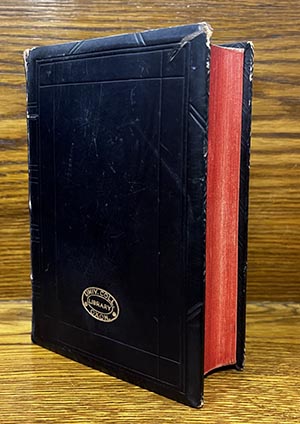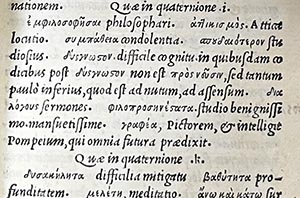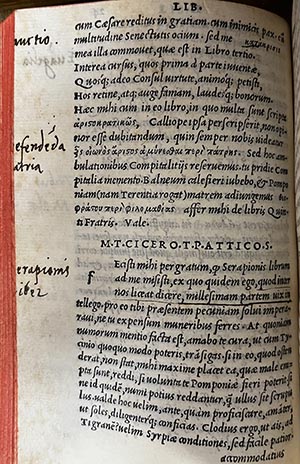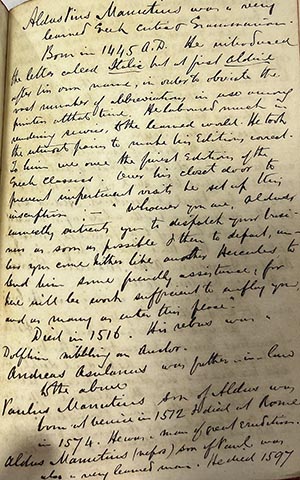The Aldine Press & its printing innovations

Figure 1
This month we are taking a look at a sweet little volume from Univ’s early printed book collections. Cicero’s Orationum volumen primum [– tertium] I, is a modest-looking book to feature in our Treasure series. However, beneath an unglamorous 19th century binding resides a text that represents several of the extraordinary developments that emerged around the beginning of 16th century printing, a mere 60 years after Guttenberg unveiled his press.
This particular volume was printed in 1513 by Aldus Manutius (Italian name Aldo Manuzio), as an imprint of the Aldine Press. The Aldine Press was founded in 1494 in Venice by Manutius, and it was managed by four generations of Manutius’s family before it closed in 1597 upon the death of Aldus Manutius the Younger, grandson of the original Aldus. This edition of Cicero was the 95th book printed at the press, according to Goldsmid¹, and it was one of the last printed by Manutius the Elder. 122 editions were printed during Manutius’s lifetime, with the final publication being Byzantini de octo partibus oratonis by Constantine Lascaris, printed in quarto size. Manutius died in early 1515, upon which time the management of the press transferred to his wife, Maria, and his father-in-law, Andrea Torresano.
Aldus Manutius was an ambitious printer, who introduced several revolutionary innovations to the bibliographic world. A dedicated classicist, he desired to publish faithful versions of seminal Greek and Latin texts in their original languages, and to make these texts available to wider audiences. Ancient Greek texts, being chiefly preserved in manuscript at this time, were particularly vulnerable to loss. This was in part due to the difficulty of capturing the complexity of Greek manuscript in metal type. The preservation of these texts was therefore immutably connected to the fragility of extant manuscripts. Modern scholars have much to thank Manutius for, as his project to faithfully reproduce classical masterpieces may well have been the lifeblood for the preservation of Hellenic studies.
Manutius’s dedication to his Hellenic project was such that he developed a cursive style of Greek type that required over 450 type-pieces². Setting Greek type was very complicated, so Manutius’s team of type-setters all must have had a good understanding of the language in order to reproduce the text without error. We can see elements of this complex type throughout this Cicero edition, with key philosophical terms presented in both Greek and Latin. More prevalent in this edition, however, is another of Manutius’s innovative types. The Aldine Press’s 1501 edition of Virgil presented, for the first time, italic type. So named because of its Italian origin, the sloped style was developed to imitate calligraphic handwriting and was reportedly inspired directly from the handwriting of Petrarch³. The font was produced by Francesco Griffo of Bologna, who had also designed all of Manutius’s earlier types, and, as Goldsmid writes, “the little italic caused a revolution in printing, for… imitations sprang up” at printing presses across Europe.4
As well as type, Manutius innovated in the format and size of books. In 1497, the Aldine Press published an edition of Hours of the Blessed Virgin according to the custom of the Roman court, a Book of Hours, in a revolutionary new format. This edition was printed in octavo size, a smaller, less cumbersome size of book than had been hitherto available. Previously, printed books were produced in folio or quarto format, with the names referring to the number of leaves contained within each section of pages. Leaves are produced as a result of folding the original sheet of paper onto which text is printed, and a book is made up of a number of these sections sewn together. Folios are made with one fold of the paper to create two very large leaves in each section, and quartos use two folds to create four – still quite large – leaves. The octavo size uses three folds to create eight smaller leaves, resulting in a book that can be comfortably held in the reader’s hands. This change in format subsequently shifted reading from an activity that bound one to a lectern or desk, required to hold up the book, into a newly portable pastime that readers could practice anywhere. The Aldine Press was most famous for producing their classical Greek and Latin texts in this accessible octavo format. Readers of the octavo edition were thus able to study their orations or treatises anywhere within their home, and even travel with their collection of classics. Univ’s Cicero is one such octavo edition. In Univ’s copy we can see evidence of how the book’s previous readers have engaged with the text, as they have added manuscript marginalia throughout the book.
Regrettably, many of the annotations have been lost or obscured during the re-binding of the book, during which the pages were re-cut to create a clean new foredge. This re-binding was most likely carried out during the 19th century, which dates the annotations to an earlier period in the book’s life. However, our 19th century book collector ¬– possibly the 1st Earl of Cromer, whose bookplate is present on the new endleaf – was evidently enthusiastic about the Aldine Press. On the final pages is a handwritten history of the Press and of Manutius’s life and career, in which the biographer describes the printer as “a very learned Greek critic and grammarian”. This manuscript fits neatly within the page and was clearly written after the book was re-bound.
In Univ’s copy we can see the publisher’s device, an image of a dolphin wrapped around an anchor (see below). The dolphin-anchor emblem has since Roman times been used to illustrate the classical motto festina lente, or more haste less speed, and here it illustrates Manutius’s commitment to publishing meticulous editions while working to a rapid scale. The Aldine Press first used this device in 1501, and it was quickly forged by other printers domestically and across Europe. In only seven years, the Aldine Press had earned a reputation for quality that less meticulous printers sought to exploit. As the biographer in Univ’s copy writes admiringly, Manutius “laboured much in rendering services [to] the learned world… he took the utmost pains to make his editions”. It is no wonder, then, that this copy, at over 500 years old, is in excellent condition. Perhaps out of respect for the quality of the edition, or respect for the printing traditions it represents, multiple generations of book collectors have treasured this volume.

Figure 5
Univ is lucky enough to keep a collection of Aldines that were donated by Oliver Bell (Old Member, m. 1919). Future Treasures may well explore the curious histories of these additional Aldines.
1 Renouard, Ant. Aug. (Antoine Augustin), and Edmund. Goldsmid. A Bibliographical Sketch of the Aldine Press at Venice, Tr. and Abridged from “Annales de l’imprimerie Des Aldes”, Revised and Corrected by E. Goldsmid. Edinburgh, 1887.
2 Gaskell, Philip. A New Introduction to Bibliography. Reprinted with corrections. New Castle, Del: Oak Knoll P., 1995.
3 Renouard, Ant. Aug. (Antoine Augustin), and Edmund Goldsmid. A Bibliographical Sketch of the Aldine Press at Venice, Tr. and Abridged from “Annales de l’imprimerie Des Aldes”, Revised and Corrected by E. Goldsmid. Edinburgh, 1887
4 Ibid.
Bibliography
RR. 22.39, Cicero: Epistolarum ad Atticum, ad Brutum, ad Quintum fratrem, libri XX. Latina interpretatio eorum, quae in iis ipsis epistolis graece scriptae sunt. Ubi multa & mutata, & addita sunt. Admonemus igitur lectorem, ut inde sibi librum corrigat suum (Venice, 1513).
References
Gaskell, Philip. A New Introduction to Bibliography. Reprinted with corrections. New Castle, Del: Oak Knoll P., 1995.
Renouard, Ant. Aug. (Antoine Augustin), and Edmund. Goldsmid. A Bibliographical Sketch of the Aldine Press at Venice, Tr. and Abridged from “Annales de l’imprimerie Des Aldes”, Revised and Corrected by E. Goldsmid. Edinburgh, 1887.
Published: 22 November 2023



